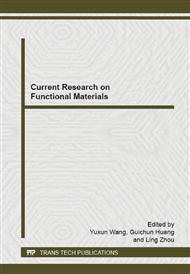[1]
To-Hoai N, Dong-Keun Y, Dukjoon K. Batch and column separation haracteristics of copper-imprinted porous polymer micro-beads synthesized by a direct imprinting method [J]. Journal of Hazardous Materials, 2010, 173: 462-467.
DOI: 10.1016/j.jhazmat.2009.08.107
Google Scholar
[2]
Chakravarti A K, Chowdhury S B, Mukherje D C. Liquid membrane multiple emulsi process of separation of copper(II) from waste waters [J]. Colloids and Surfaces, 2000, 166: 7-25.
DOI: 10.1016/s0927-7757(99)00452-5
Google Scholar
[3]
Wang N, Han Y J, Liu Y. High-strength hydrogel as a reusable adsorbent of copper ions [J]. Journal of Hazardous Materials, 2012, 213-214: 258-264.
DOI: 10.1016/j.jhazmat.2012.01.092
Google Scholar
[4]
Zhang Ling, Cao Zhong, Chen Ping, et al. Electrosorptive deionization with activated carbon[J]. Journal of functional materiala, 2008, 39(10): 1727-1730.
Google Scholar
[5]
Guo Jiajia, Su qingde, Ling Fei, et al. Erbium(Ⅲ)-ion imprinted silica gel sorbent:synthesis and selective solid—phase extraction[J]. Journal of functional materiala, 2010, 41(z2): 288-291.
Google Scholar
[6]
Xu L Q, Zhang W Q, Yang Q. A novel route to hollow and solid carbon spheres [J]. Carbon, 2005, 43(5): 1090-1092.
DOI: 10.1016/j.carbon.2004.11.032
Google Scholar
[7]
Emil F A, Veslav C B, Yury A D. Modification of the proton conducting membranes of MF-4SC with a carbon phasevia gamma-initiated graft polymerization of vinyliden chloride [J]. Solid State Ionics, 2011, 188: 140-143.
DOI: 10.1016/j.ssi.2010.09.026
Google Scholar
[8]
Jung C H, Kim D K, Choi J H. Surface modification of multi-walled carbon nanotubes by radiation-induced graft polymerization [J]. Current Applied Physics, 2009, 9: S85-S87.
DOI: 10.1016/j.cap.2008.08.013
Google Scholar
[9]
Li Peng, Lv Wangchun, Wang Jin, et al. Surface modification by chitosan-grafted PET and evaluation of its bacterial adherence[J]. Journal of functional materiala, 2004, 35(z1): 2443-2448.
Google Scholar
[10]
Abdelghani L, Alexandre V, Gérard N. A chemical method to graft carbon nanotubes onto a carbon fiber [J]. Materials Letters, 2008, 62: 394-397.
Google Scholar
[11]
Chao Wang, Xiaodong He, Liyong Tong. Theoretical prediction and experimental verification of pulling carbon nanotubes from carbon fiber prepared by chemical Grafting method [J]. Composites: Part A 50 (2013) 1–10.
DOI: 10.1016/j.compositesa.2013.03.008
Google Scholar
[12]
Deng J P, Wang L F, Liu L Y. Developments and new applications of UV-induced surface graft polymerizations [J]. Progress in Polymer Science, 2009, 34: 156-193.
DOI: 10.1016/j.progpolymsci.2008.06.002
Google Scholar
[13]
Wu Xiuli, Xue Donghua, Xu Kun, et al. Preparation and characterization of graft copolymer of acryloyloxyethyl trimethylammonium chloride and starch[J]. Journal of functional materiala, 2008, 99: 1008-1010.
Google Scholar
[14]
LI Ding, Gao Baojiao, Wei Xiaopeng. Preparation of grafted SiO2-g-PMAA particles with high grafting degree via a surface-initiated graft polymerization method [J]. Journal of applied chemistry, 2011, 28: 154-158.
Google Scholar


